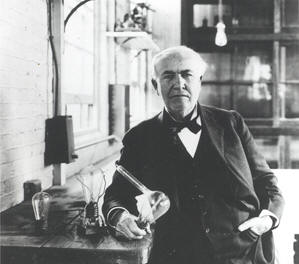Early Applications of Electric Power: Difference between revisions
No edit summary |
No edit summary |
||
| Line 1: | Line 1: | ||
[[Image:Edison with light bulb.jpg| | [[Image:Edison with light bulb.jpg|thumb|left|Thomas Edison with Light Bulb]] | ||
1882 was a momentous year for electric power. Most important was the inauguration on September 4th of that year of Thomas Edison's power station on Pearl Street in New York City. Edison, who had invented a practical incandescent bulb in 1879, developed an electric-power system to make electric lighting available to large numbers of people. The Pearl Street generator produced 100 kilowatts and served some 500 customers in lower Manhattan. Earlier that year, the Edison company in Britain had put into service a power station at Holborn Viaduct in London. This was the first commercial central station in the world, but it was intended only as a temporary installation, so the Pearl Street station is often regarded as marking the beginning of electric-power distribution. | 1882 was a momentous year for electric power. Most important was the inauguration on September 4th of that year of Thomas Edison's power station on Pearl Street in New York City. Edison, who had invented a practical incandescent bulb in 1879, developed an electric-power system to make electric lighting available to large numbers of people. The Pearl Street generator produced 100 kilowatts and served some 500 customers in lower Manhattan. Earlier that year, the Edison company in Britain had put into service a power station at Holborn Viaduct in London. This was the first commercial central station in the world, but it was intended only as a temporary installation, so the Pearl Street station is often regarded as marking the beginning of electric-power distribution. | ||
Several other central stations began operating before the end of 1882. On 30 September, in Appleton, Wisconsin, a hydroelectric station, rated at about 12 kilowatts, went into service; and in October 1882, a rival to Edison's company, the United States Electric Illuminating Company, opened its first central station in South Carolina. These two power stations are recognized as IEEE Milestones in Electrical Engineering and Computing. [[ | Several other central stations began operating before the end of 1882. On 30 September, in Appleton, Wisconsin, a hydroelectric station, rated at about 12 kilowatts, went into service; and in October 1882, a rival to Edison's company, the United States Electric Illuminating Company, opened its first central station in South Carolina. These two power stations are recognized as IEEE Milestones in Electrical Engineering and Computing. [[Charles F. Brush|Charles Brush]], inventor of electric arc-lamps, built a central power station in New York City that powered both incandescent and arc lights, that went into service on 19 December 1882. | ||
In Europe as well, the year 1882 was an exciting one for the people and companies developing the new electrical technologies. Two international electrical exhibitions took place that year, one in the Crystal Palace in South London and the other in Munich. In Germany, a leading developer was Werner Siemens, who was one of the first to see how important electrical technology would be to mining. The Siemens & Halske company built the first electric mine-locomotive, which was first utilized on 25 August 1882 at a mine in Lower Saxony. | In Europe as well, the year 1882 was an exciting one for the people and companies developing the new electrical technologies. Two international electrical exhibitions took place that year, one in the Crystal Palace in South London and the other in Munich. In Germany, a leading developer was Werner Siemens, who was one of the first to see how important electrical technology would be to mining. The Siemens & Halske company built the first electric mine-locomotive, which was first utilized on 25 August 1882 at a mine in Lower Saxony. | ||
[[Category:Power,_energy_&_industry_application|Category:Power,_energy_&_industry_application]] [[Category:Power_generation]] | [[Category:Power,_energy_&_industry_application|Category:Power,_energy_&_industry_application]] [[Category:Power_generation]] | ||
Revision as of 15:06, 24 September 2008
1882 was a momentous year for electric power. Most important was the inauguration on September 4th of that year of Thomas Edison's power station on Pearl Street in New York City. Edison, who had invented a practical incandescent bulb in 1879, developed an electric-power system to make electric lighting available to large numbers of people. The Pearl Street generator produced 100 kilowatts and served some 500 customers in lower Manhattan. Earlier that year, the Edison company in Britain had put into service a power station at Holborn Viaduct in London. This was the first commercial central station in the world, but it was intended only as a temporary installation, so the Pearl Street station is often regarded as marking the beginning of electric-power distribution.
Several other central stations began operating before the end of 1882. On 30 September, in Appleton, Wisconsin, a hydroelectric station, rated at about 12 kilowatts, went into service; and in October 1882, a rival to Edison's company, the United States Electric Illuminating Company, opened its first central station in South Carolina. These two power stations are recognized as IEEE Milestones in Electrical Engineering and Computing. Charles Brush, inventor of electric arc-lamps, built a central power station in New York City that powered both incandescent and arc lights, that went into service on 19 December 1882.
In Europe as well, the year 1882 was an exciting one for the people and companies developing the new electrical technologies. Two international electrical exhibitions took place that year, one in the Crystal Palace in South London and the other in Munich. In Germany, a leading developer was Werner Siemens, who was one of the first to see how important electrical technology would be to mining. The Siemens & Halske company built the first electric mine-locomotive, which was first utilized on 25 August 1882 at a mine in Lower Saxony.
